Want more essential tips for painting with oil paints? In part two of the 10-tip series on oil painting, I’ve illustrated some of my points using my painting entitled Zun Odor (Summer Day). The subject is a Mongolian herder I photographed on one of my trips to Mongolia in 2012. It’s 30 x 40″, done in oil on a RayMar canvas board. Use these oil painting tips to get started created your own works of art!
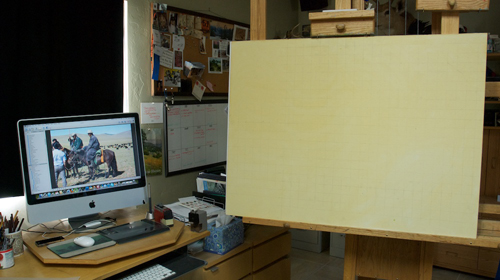
My studio set-up: You can see my reference photo on the computer screen. The panel is tinted and the pencil grid for the drawing transfer is done.
5 must-know tips for oil painting : part two
[box type=”shadow”]
If you missed part one, you can check out the first five oil painting tips here!
[/box]
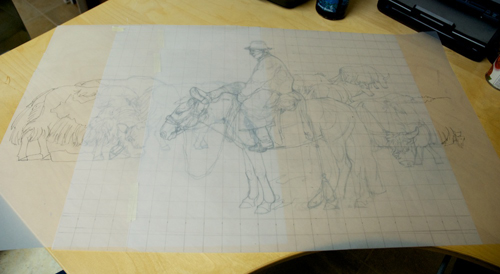
The tracing paper drawings which I will transfer to the canvas using a sheet of graphite transfer paper
6. Understand the five elements
There are five elements that are present in every representational painting: design/composition, drawing, values, color and edges. One of the best presentations of these elements is in Richard Schmid’s classic book, Alla Prima: Everything I Know About Painting.
Design/composition:
Once you have the idea for your painting, it’s a good idea to do thumbnail sketches, maybe just 1-2″ in size to work out the design. Don’t get into detail, just work on arranging the main elements. Try different proportions of rectangles or maybe see how it might look as a square. Edgar Payne’s Composition of Outdoor Painting is another classic resource.
Drawing:
Once you have a design, then it’s time to draw it. You might do a pencil study first, then transfer it to your canvas. Or you could start by drawing directly with a brush on the canvas, either in line or shape. Either way, be as accurate as you can. There are many great books on drawing but, in the end, the only way to learn how to draw is…to draw. A lot.
Values
Value is the relationship between light and dark, separate from the color or hue it might be. Fantastic paintings always have great value relationships. You want the area of highest contrast to be where the center of interest is — where you want the viewers eye to go first. Take a look at the monochrome paintings of Frederic Remington. He was a master of values.
Color
We all love color. It’s a big part of what makes painting fun. But, because the number of colors are endless, it’s easy to get lost in trying to understand what colors to use to convey what you want to say. A good color wheel is very helpful when you’re starting out. You can also take Bluprint classes like The Oil Painter’s Handbook and Painting With Color: A Contemporary Approach.
Edges
Edges are where the different elements of your painting come together. To handle them well means being responsible for making decisions about the quality of every edge, determining how hard or soft it should be. Variety of edges is one of the things that sets great paintings apart from merely good ones. Pick an artist or subject you like, google them and add the word “paintings”. Go through a number of the images, enlarging them if you can and see how many different edge treatments you can find. Then, think about how to apply what you’ve learned to your own work.

The initial brush drawing, making corrections as needed
7. Don’t paint the object.
Yes, you’re painting flowers or a landscape with trees or a portrait, but what you really have is paint, canvas, brushes and knowledge of how to use them. A workshop instructor once pointed out that there is no tube of paint labelled “the light in a child’s eye”. We have to create that light through the use of shapes, values, edges, color hue and temperature — the craft of painting. This is a kind of abstract thinking that is very liberating and also a different way of seeing the world.
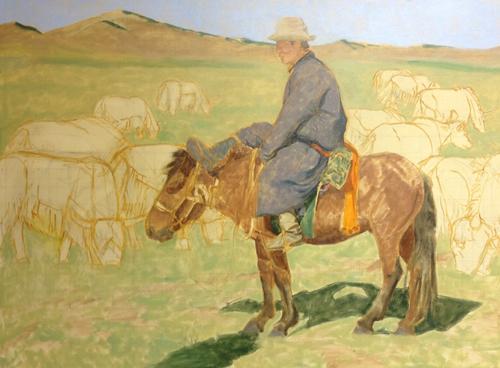
My first color pass: Notice that I’m treating the yaks a single shapes.
8. Learn to draw.
Painting is a form of drawing, whether it is representational or abstract. They are not two separate things. You have to accurately observe your subject and then have the motor skills for your hand to put down what you see. These skills take time and effort to acquire.
John Ruskin, the great Victorian art critic and writer, felt strongly that anyone could learn to draw “…I have never yet, in the experiments I have made, met with a person who could not learn to draw at all; and, in general, there is a satisfactory and available power in everyone to learn drawing if he wishes…” This is from his book The Elements of Drawing (which is available now as a free e-book). What you are really doing is learning to see in particular way using your hand and brain.
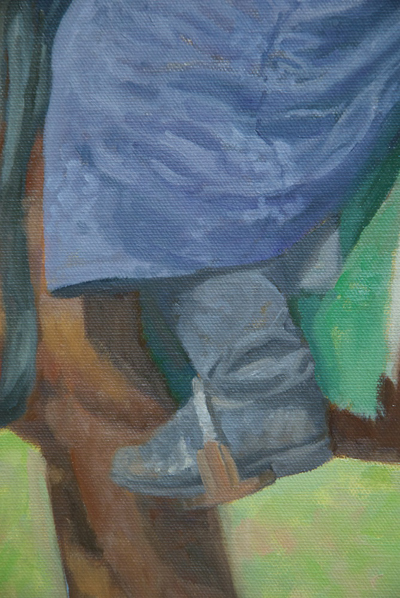
This detail shows a variety of edge treatments: The drapery has soft edges while the stirrup has hard edges.
9. A painting can have only one idea.
Everything else must be subordinated to the central idea of your painting, even that perfect bit that you love. If it doesn’t support the idea, the inspiration that made you decide to do the painting in the first place, then away it must go. There are a variety of “tools” at your disposal to accomplish this, some of which have been discussed under #6.
If the painting is about a wonderful old oak tree, then you don’t want a bright red barn to compete with it. Either leave the barn out, change its color to something more neutral or push it back by making it a lighter value.

This image shows the detail of one of the yaks. Notice that I am not painting hairs, but clumps, using a round brush. There is a variety of shapes, colors and colors temperatures.
10. Be objective about your work: not too judgmental, not too forgiving.
Being either overly critical or overly forgiving will get in the way of your growth as an artist. This is not easy, but it is necessary. Everyone has a bad or at least not-so-good day in the studio, sometimes wondering why they ever thought they could be a painter. My experience is that the struggle means growth is happening. The only thing to do is to pick up the brush and go on.
When the work is cruising along, it’s really nice, but it’s also a plateau. If you get too happy with your work then you won’t see what you need to work on. And everyone has areas where they can improve. So, the best thing to do is to strike a balance and never lose track of the joy. Because, really, what a privilege it is to be an artist!
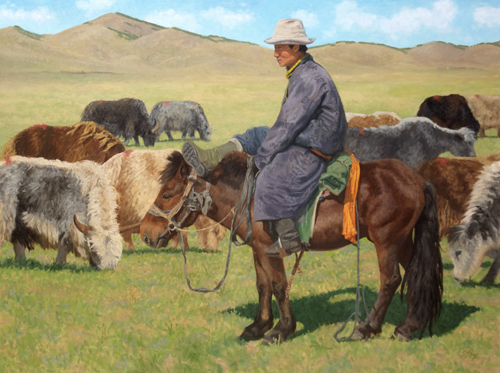
The finished painting: Zun Odor (Summer Day) oil 30 x 40

wonderful! I wish you would do a vidio or U-tube i would love to follow along step by step. Thank you- most delightful
Very nice work